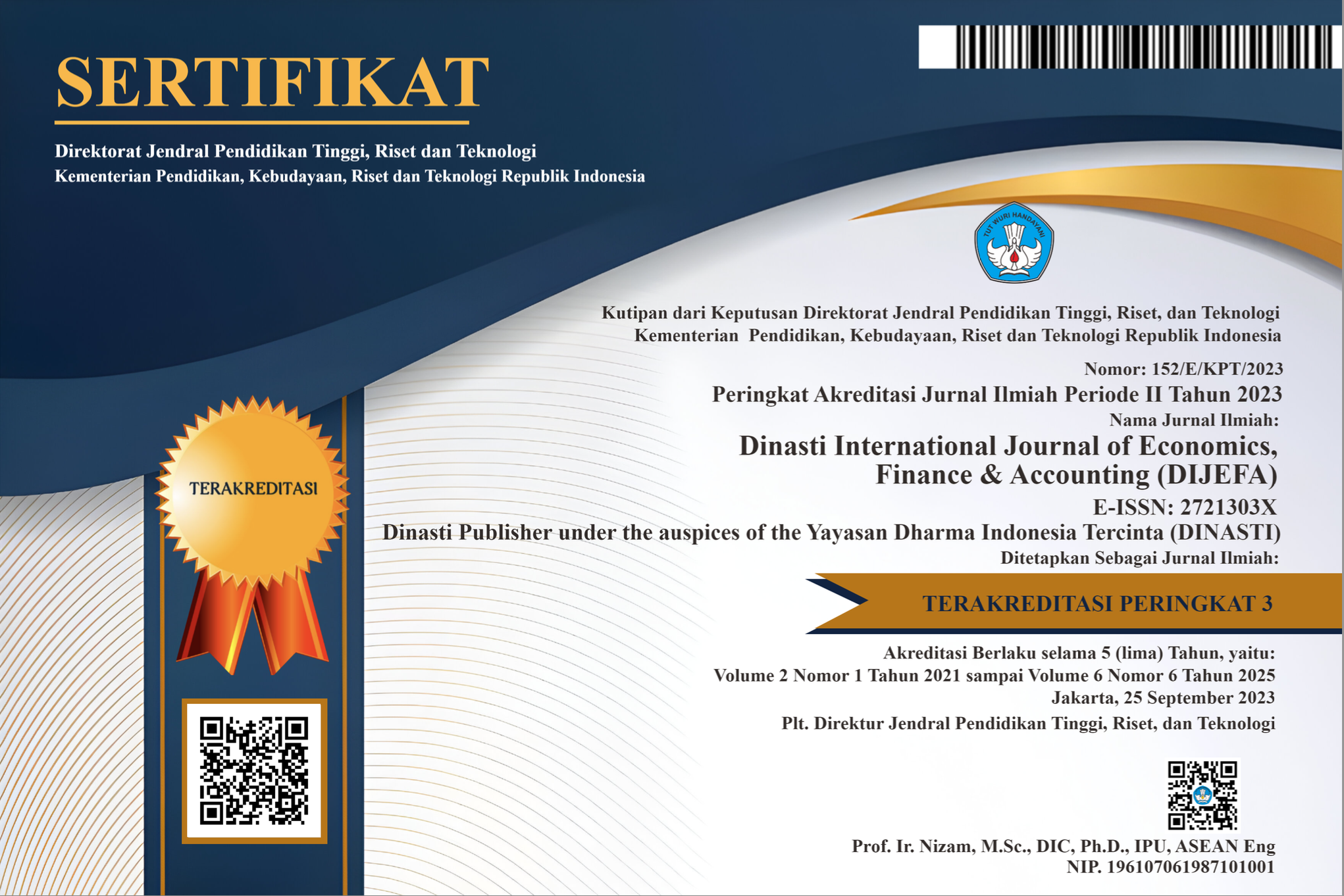Marketing Strategies of Sharia Peer-to-Peer Lending Fintech in Enhancing Sharia Financial Inclusion: A Case Study of PT. Dana Syariah Indonesia
DOI:
https://doi.org/10.38035/dijefa.v5i3.3082Abstract
This study aims to analyze the marketing strategies employed by PT. Dana Syariah Indonesia in enhancing Sharia financial inclusion through Sharia peer-to-peer lending fintech. The research uses SWOT and QSPM analyses to evaluate the company's strengths, weaknesses, opportunities, and threats in its marketing strategies. The findings reveal that the company has successfully increased access to Sharia financial services by utilizing digital media, offline events, and advanced technology. Despite challenges such as customer complaint management and digital adoption barriers, the company leverages market opportunities sensitive to riba and strengthens its position through solutions aligned with Sharia values. The study concludes that effective marketing strategies play a crucial role in expanding Sharia financial inclusion in Indonesia.
References
Alma, B. (2004). Manajemen Pemasaran dan Pemasaran Jasa. Alfabeta.
Amarullah, A. (2021). Fintech Keuangan Syariah dalam Perspektif Konsep Syariah. Jurnal Ekonomi Dan Perbankan Syariah, 08(02).
Assauri, S. (1993). Manajemen Pemasaran. Rajawali Press.
Astana, I. G. M. O., & Andriyani, K. A. S. (2023). Analisis Strategi Pemasaran Dalam Meningkatkan Kinerja Penjualan di CV Umah Luwung. Jurnal Daya Saing, 9(1), 41–48.
Baihaqi, J. (2018). Financial Technology Peer-To-Peer Lending Berbasis Syariah Di Indonesia. TAWAZUN?: Journal of Sharia Economic Law, 1(2), 116. https://doi.org/10.21043/tawazun.v1i2.4979
Dharmastuti, C. F., & Laurentxius, J. (2021). Factors and Benefits that Affect Lender’s Interest in Giving Loans in Peer to Peer (P2P) Lending Platform. Binus Business Review, 12(2), 121–130. https://doi.org/10.21512/bbr.v12i2.6359
Djaakum, C. S. (2019). Peer to Peer Lending Against Ease of Business Technology Acceptance Model (TAM) Approach. Economica: Jurnal Ekonomi Islam, 10(2), 217–238. https://doi.org/10.21580/economica.2019.10.2.3476
Harp, A. P., Resfa Fitri, & Yekti Mahanani. (2021). Peer-to-Peer Lending Syariah dan Dampaknya terhadap Kinerja serta Kesejahteraan Pelaku Usaha Mikro dan Kecil (UMK) pada Masa Pandemi Covid-19. Al-Muzara’Ah, 9(1), 109–127. https://doi.org/10.29244/jam.9.1.109-127
Hiyanti, H., Nugroho, L., Sukmadilaga, C., & Fitrijanti, T. (2020). Peluang dan Tantangan Fintech (Financial Technology) Syariah di Indonesia. Jurnal Ilmiah Ekonomi Islam, 5(3), 326–333. https://doi.org/10.29040/jiei.v5i3.578
Hurriyati, R. (2010). Bauran Pemasaran dan Loyalitas Pelanggan. Alfabeta.
Hussnain, S. (2011). What Is Islamic Marketing. Global Journal of Management and Business …, 11(11), 100–103. https://globaljournals.org/GJMBR_Volume11/10.What-Is-Islamic-Marketing.pdf
Huston, S. J. (2010). Measuring Financial Literacy. Journal of Consumer Affairs, 44(2), 296–316. https://doi.org/10.1111/j.1745-6606.2010.01170.x
Informasi Statistik Infrastruktur PUPR. (2021). Buku Informasi Statistik Infrastruktur PUPR. Angewandte Chemie International Edition, 6(11), 951–952., 1–110.
Irkham Firdaus, M., Akmal, H., & Bin Lahuri, S. (2022). Implementation of Murabahah Agreement on Peer to Peer Lending Platform. ISLAMICONOMIC: Jurnal Ekonomi Islam, 12(2), 191–204. https://doi.org/10.32678/ijei.v12i2.249
Kasmir. (2016). Bank dan Lembaga Keuangan Lainnya (ke-17). RajaGrafindo Persada.
Kementerian Komunikasi dan Informatika RI. (2022). “Wapres Minta MES Kerja Cepat dan Kompak.” https://www.kominfo.go.id/content/detail/44800/wapres-minta-mes-kerja-cepat-dan-kompak/0/berita
Khuluqi, A. (2021). ANALISIS MAQ??ID AL-SH?RI’AH TERHADAP PENGGUNAAN E-MONEY SEBAGAI MEDIA PENYIMPANAN ASET KEUANGAN KELUARGA. Universitas Islam Negeri Sunan Ampel.
Kotler, P. (2013). Manajemen Pemasaran (13th ed.). Erlangga.
Kresna Riady, D., Soemitra, A., Nawawi, Z. M., Islam, U., & Sumatera Utara, N. (2022). Commons Attribution-NonCommercial 4.0 International license Growth in Financial Technology (Fintech) Transactions in Banking During the Covid-19 Pandemic Pertumbuhan Transaksi Financial Technology (Fintech) Di Dalam Perbankan. Management Studies and Entrepreneurship Journal, 3(2), 634–643. http://journal.yrpipku.com/index.php/msej
Kurniaputri, M. R., & Fatwa, N. (2022). Behavioral Intention of Islamic Peer-To-Peer Lending Services Users. Jurnal Ekonomi Dan Bisnis Islam (Journal of Islamic Economics and Business), 8(2), 179–200. https://doi.org/10.20473/jebis.v8i2.34212
Lestari, P. C. A. (2022). Crowdfunding Donation Based di Masa Pandemi Covid-19?: Analisi Faktor Berpengaruh Pada Minat Pengguna Fintech Syariah. Jurnal Pendidikan Ekonomi, 16(2), 173–180. https://doi.org/10.19184/jpe.v16i2.33754
Lubis, F. A. (2023). Analysis of User Reviews on the Use of Fintech Dana Syariah. International Journal of Science and Society, 5(2), 70–79. https://doi.org/10.54783/ijsoc.v5i2.671
Lubis, F. A., & Arif, M. (2023). Policy Strategy in Optimizing the Economy of Salt Farming Communities in North Sumatera and Aceh. International Journal Of Artificial Intelegence Research, 6(1), 2022. https://doi.org/10.29099/ijair.v6i1.2.460
Marginingsih, R. (2021). Financial Technology (Fintech) Dalam Inklusi Keuangan Nasional di Masa Pandemi Covid-19. Moneter - Jurnal Akuntansi Dan Keuangan, 8(1), 56–64. https://doi.org/10.31294/moneter.v8i1.9903
Muhammad, R., & Lanaula, R. (2019). Challenges of Islamic Supervisory in The Islamic Financial Technology Industry. Economica: Jurnal Ekonomi Islam, 10(2), 311–338. https://doi.org/10.21580/economica.2019.10.2.3400
Naqiya, A. (2024). Sistem fintech syariah Indonesia terbaik ketiga di dunia pada 2023/2024. Tech in Asia. https://id.techinasia.com/sistem-fintech-syariah-indonesia
Nawawi, Z. M., Soemitra, A., & Dalimunthe, M. (2022). Women’s Economic Empowerment Through Sharia Micro-Finance Institutions In Indonesia: A Qualitative Research. Iqtishadia, 15(2), 255. https://doi.org/10.21043/iqtishadia.v15i2.15902
Nigmonov, A., & Shams, S. (2021). COVID-19 pandemic risk and probability of loan default: evidence from marketplace lending market. Financial Innovation, 7(1). https://doi.org/10.1186/s40854-021-00300-x
Nurbaiti, N., Asmuni, A., Soemitra, A., Imsar, I., & Aisyah, S. (2023). Behavior analysis of MSMEs in Indonesia using fintech lending comparative study between sharia fintech lending and conventional fintech lending. JPPI (Jurnal Penelitian Pendidikan Indonesia), 9(4), 92. https://doi.org/10.29210/020232273
Nurfalah, I., & Rusydiana, A. S. (2019). Digitalisasi Keuangan Syariah Menuju Keuangan Inklusif: Kerangka Maqashid Syariah. Ekspansi: Jurnal Ekonomi, Keuangan, Perbankan Dan Akuntansi, 11(1), 55. https://doi.org/10.35313/ekspansi.v11i1.1205
OJK. (2022). “Infografis Hasil Survei Nasional Literasi dan Inklusi Keuangan Tahun 2022.” https://www.ojk.go.id/id/berita-dan-kegiatan/info-terkini/Pages/Infografis-Survei-Nasional-Literasi-dan-Inklusi-Keuangan-Tahun-2022.aspx
Otoritas Jasa Keuangan. (2021). PENTING! SIMAK BEDANYA, INI CIRI-CIRI PINJOL LEGAL DAN ILEGAL. OJK. https://pasarmodal.ojk.go.id/News/Detail/20463
Palinggi, S., & Allolinggi, L. R. (2020). Analisa Deskriptif Industri Fintech di Indonesia: Regulasi dan Keamanan Jaringan dalam Perspektif Teknologi Digital. Ekonomi Dan Bisnis, 6(2), 177–192. https://doi.org/10.35590/jeb.v6i2.1327
Parhan, M., Taufik Rakhmat, A. T. R., Abyan Ashshidqi, M., Sylvia Dewi, L., Bunga Edelweis, S. L., & Regina Prayoga, F. (2022). Islamic Financial Planning: Konsep Literasi Keuangan Syariah Sebagai Alternatif Perencanaan Finansial Bagi Mahasiswa. Ekonomi Islam, 13(1), 65–84. https://doi.org/10.22236/jei.v13i1.8417
Prabu Prakoso, J. (2020). Ekonomi Syariah Melesat, Tapi Kualitas SDM Belum Bisa Mengimbangi. Bisnis.Com. https://ekonomi.bisnis.com/read/20201229/9/1336563/ekonomi-syariah-melesat-tapi-kualitas-sdm-belum-bisa-mengimbangi
Qadri, R. A., Nabilah, I., & Ambarwati, R. D. (2022). Black-or-White of Online Lending in Indonesia: Conventional Platform or Sharia Scheme (A Netnography Study). Jurnal Ilmiah Akuntansi Dan Bisnis, 17(2), 184. https://doi.org/10.24843/jiab.2022.v17.i02.p01
Rafiki, A. (2021). Manajemen dan Bisnis Islam. PT Raja Grafindo Persada.
Rahim, S. H. A., Rashid, R. A., & Hamed, A. B. (2016). Islamic financial literacy and its determinants among university students: An exploratory factor analysis. International Journal of Economics and Financial Issues, 6(7Special Issue), 32–35.
Rangkuti. (2006). Teknik Membedah Kasus Bisnis Analisis SWOT. Gramedia Pustaka Utama.
Rohman, A. N. (2023). Urgensi Pengaturan Fintech Lending Syariah Di Indonesia: Analisis Perlindungan Hukum Bagi Pengguna Layanan. Jurnal Legislasi Indonesia, 20(1), 16. https://doi.org/10.54629/jli.v20i1.991
Saraswati, B. D., & Tisnawati, N. M. (2021). Pengaruh Financial Technology (Fintech) Terhadap Stabilitas Sistem Keuangan Di Indonesia. E-Jurnal Ekonomi Dan Bisnis Universitas Udayana, 10(10), 921. https://doi.org/10.24843/eeb.2021.v10.i10.p09
Setiawan, D., Darwanto, D., & Gunanto, E. Y. A. (2021). Determinants of Behavioral Intentions to Use Sharia Financial Technology (Fintech). Signifikan: Jurnal Ilmu Ekonomi, 10(2), 325–342. https://doi.org/10.15408/sjie.v10i2.21451
Soemitra, A. (2023). Financial Technology Syariah di Indonesia. Febi UINSU Press.
Sugiyono. (2013). Metode Penelitian Kuantitatif Kualitatif Dan R & D. Alfabeta.
Surfshark. (2022). Jumlah Akun yang Mengalami Kebocoran Data di Indonesia (Kuartal I 2020-Kuartal II 2022). https://surfshark.com/research/data-breach-monitoring
Syariah, D. (2021). No. https://www.danasyariah.id/
Tandiono, J., Djojo, B. W., Candra, S., & Heriyati, P. (2020). Finding Customer Perception of Peer-to-Peer (P2P) Lending Financial Technology in Pohon Dana. Binus Business Review, 11(1), 51–58. https://doi.org/10.21512/bbr.v11i1.6014
Terate Sari, K., Ekonomi dan Bisnis, F., Terate Sari Ekonomi, K., Brawijaya, U., & Atu Bagus Wiguna, I. (2022). Tingkat Kepemilikan Rumah Di Indonesia. Contemporary Studies in Economic, 1(3), 466–479. http://dx.doi.org/10.21776/csefb.2022.01.3.09.
Tjiptono, F. (1995). Strategi Pemasaran. ANDI.
Tritto, A., He, Y., & Junaedi, V. A. (2020). Governing the gold rush into emerging markets: a case study of Indonesia’s regulatory responses to the expansion of Chinese-backed online P2P lending. Financial Innovation, 6(1). https://doi.org/10.1186/s40854-020-00202-4
Umar. (2008). Strategic Management in Action. PT Gramedia Pustaka Utama.
Umar Habibu Umar. (2022). Integrating Islamic Fintech into Islamic Social Finance to Revive the Going Concern of MSMEs in the COVID-19 Era. Global Review of Islamic Economics and Business, 10(1), 1–13.
Viana, E. D., Febrianti, F., & Dewi, F. R. (2022). Literasi Keuangan, Inklusi Keuangan dan Minat Investasi Generasi Z di Jabodetabek. Jurnal Manajemen Dan Organisasi, 12(3), 252–264. https://doi.org/10.29244/jmo.v12i3.34207
Wijaya, C., Nugroho, B. Y., & Arkanuddin, M. F. (2022). The Analysis of Risk Effect Towards Fintech Ecosystem On P2P Lending Industry in Indonesia. Indonesian Journal of Business and Entrepreneurship, 8(3), 481–491. https://doi.org/10.17358/ijbe.8.3.481
Yulianto, M. A., & Rita, M. R. (2023). Mediasi Perilaku Pengelolaan Keuangan Dalam Pengaruh Fintech Dan Literasi Keuangan Terhadap Kinerja Usaha. EKUITAS (Jurnal Ekonomi Dan Keuangan), 7(2), 212–232. https://doi.org/10.24034/j25485024.y2023.v7.i2.5260
Downloads
Published
How to Cite
Issue
Section
License
Copyright (c) 2024 Ahmad Fuadi Tanjung, Sugianto Sugianto, Rahmi Syahriza

This work is licensed under a Creative Commons Attribution 4.0 International License.
Authors who publish their manuscripts in this journal agree to the following conditions:
- The copyright on each article belongs to the author(s).
- The author acknowledges that the Dinasti International Journal of Economics, Finance & Accounting (DIJEFA) has the right to be the first to publish with a Creative Commons Attribution 4.0 International license (Attribution 4.0 International (CC BY 4.0).
- Authors can submit articles separately, arrange for the non-exclusive distribution of manuscripts that have been published in this journal into other versions (e.g., sent to the author's institutional repository, publication into books, etc.), by acknowledging that the manuscript has been published for the first time in the Dinasti International Journal of Economics, Finance & Accounting (DIJEFA).


























































